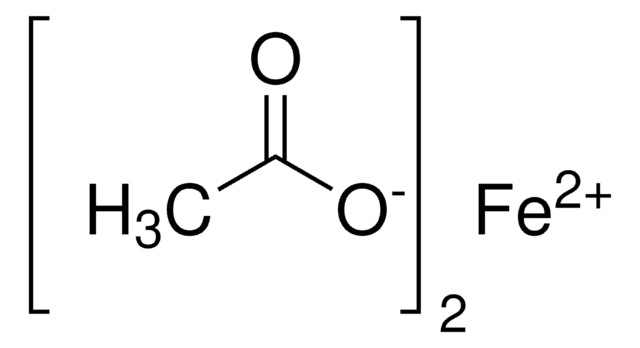413054
Iron
granular, 10-40 mesh, >99.99% trace metals basis
Synonym(s):
Ferrum, Iron metal
About This Item
Recommended Products
Quality Level
Assay
>99.99% trace metals basis
form
granular
resistivity
9.71 μΩ-cm
particle size
10-40 mesh
bp
2750 °C (lit.)
mp
1535 °C (lit.)
density
7.86 g/mL at 25 °C (lit.)
SMILES string
[Fe]
InChI
1S/Fe
InChI key
XEEYBQQBJWHFJM-UHFFFAOYSA-N
Related Categories
General description
Application
- Progress and perspectives on iron-based electrode materials for alkali metal-ion batteries: a critical review.: This review explores the recent advancements and future prospects of iron-based electrode materials in alkali metal-ion batteries, highlighting their potential for high energy density and sustainable energy storage solutions (Li et al., 2024).
- Iron-Based Electrodes Meet Water-Based Preparation, Fluorine-Free Electrolyte and Binder: : This study examines the use of water-based preparation methods and fluorine-free electrolytes in the development of iron-based electrodes, proposing a more sustainable approach to lithium-ion battery production (Valvo et al., 2017).
Signal Word
Warning
Hazard Statements
Precautionary Statements
Hazard Classifications
Flam. Sol. 2 - Self-heat. 2
Storage Class Code
4.2 - Pyrophoric and self-heating hazardous materials
WGK
nwg
Flash Point(F)
69.8 °F
Flash Point(C)
21 °C
Choose from one of the most recent versions:
Already Own This Product?
Find documentation for the products that you have recently purchased in the Document Library.
Customers Also Viewed
Articles
The price of tellurium, a key component in many thermoelectric materials, has risen in recent years, leading to the search for more cost-effective substitutes. This article presents silicide materials as a cheaper potential alternative.
Higher transition metal silicides are very well-suited for anisotropic thermoelectric conversion. Essential anisotropy of the Seebeck coefficient, together with good mechanical properties, allows production of reliable anisotropic thermoelectric converters.
The unique properties of the rare-earth elements and their alloys have brought them from relative obscurity to high profile use in common hightech applications.
Global Trade Item Number
| SKU | GTIN |
|---|---|
| 413054-25G | 4061832080819 |
| 413054-5G | 4061832080826 |
Our team of scientists has experience in all areas of research including Life Science, Material Science, Chemical Synthesis, Chromatography, Analytical and many others.
Contact Technical Service



